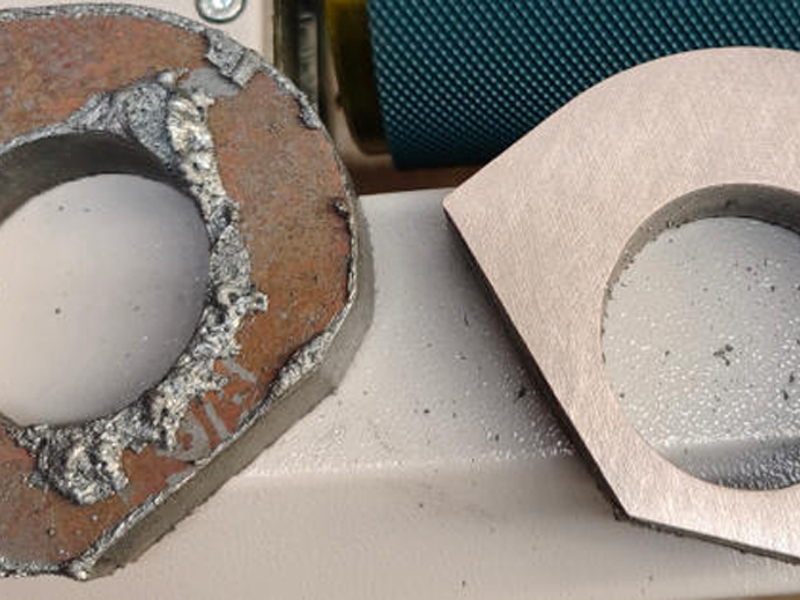In the fast-evolving world of sheet metal fabrication, laser cutting remains the gold standard for precision, speed, and versatility. High-power fiber lasers can now cut thicker materials faster than ever, producing complex parts with minimal heat distortion. However, even the cleanest laser cut leaves behind challenges: micro-burrs, razor-sharp edges, and (on carbon steel) a stubborn oxide layer. These imperfections create real problems downstream — from worker injuries and assembly issues to premature coating failures and corrosion.
This is where automatic deburring and edge rounding machines become essential. Modern systems go far beyond basic burr removal, delivering controlled edge radiusing (often up to a 2 mm radius), oxide removal, and uniform surface finishing — frequently on both sides of the part in a single pass. As fabrication shops face rising demands for quality, safety, and throughput in 2025, investing in automated finishing is no longer optional; it's a competitive necessity.
Why Laser-Cut Parts Always Need Post-Processing
Laser cutting is cleaner than plasma or punching, but it still produces:
1.Micro-burrs and sharp edges — These can slice hands, snag during handling, or damage mating components.
2.Oxide layers (especially on carbon steel cut with oxygen) — This heat-affected zone blocks weld penetration and causes paint or powder coating to peel.
3.Inconsistent edge geometry — Manual grinding varies by operator, leading to rejected parts when customers specify a minimum edge radius.
4.Edge rounding (also called edge radiusing or breaking) creates a repeatable radius on all contours — external profiles and internal cutouts alike. A radius as small as 0.3–0.5 mm dramatically improves safety and coating performance, while 1–2 mm radii are now common for heavy-duty corrosion resistance requirements.
For powder-coated or painted parts, sharp edges are the #1 cause of field failures. Surface tension pulls coating away from corners, leaving thin spots that rust first. Rounded edges allow uniform film build, extending service life and reducing warranty claims.
What Modern Automatic Deburring Machines Deliver
Today's machines (from leaders like ADV 508 Series, ADVANPOLISH and ADVANMETALTECH) integrate multiple processes:
Process | Function | Typical Tools Used |
|---|
Primary Deburring | Removes dross, heavy burrs, and vertical slag | Wide abrasive belts or drums |
Edge Rounding | Creates uniform radius on all edges/holes | Multi-directional rotary brushes |
Oxide Removal | Strips laser oxide for clean welds/coatings | Dedicated belt + brush combinations |
Surface Finishing | Applies line-grain or non-directional finish | Scotch-Brite or additional heads |
Double-Sided Processing | Finishes top and bottom simultaneously | Opposed heads or return conveyors |
Many 2025 models feature:
Automatic tool wear compensation for consistent radius from the first to the last part.
Programmable recipes with "wizard" assistants for quick material/thickness/radius changes.
Vacuum or magnetic tables for small parts (down to ~50×50 mm).
Wet dust collection for aluminum/titanium to minimize explosion risk.
Result: A laser-cut part exits burr-free, with a defined radius (R2 achievable in one pass on many systems), bright edges, and ready for bending, welding, or coating — often 50–60% faster than manual methods.Key Benefits of Automated Edge Rounding in 2025
Worker Safety & Ergonomics
Sharp edges are a leading cause of lacerations in fabrication shops. Rounded edges reduce cut risks and PPE requirements.
Superior Coating Performance
Uniform radius prevents "edge pull-away" in powder coating, improving salt-spray resistance and durability — critical for outdoor/agricultural equipment.
Consistency & Quality Control
Machine parameters deliver repeatable radii and Ra values, simplifying PPAPs and audits for automotive/aerospace OEMs.
Throughput & ROI
Shops report 5–10× faster finishing than hand grinding, plus lower rework, fewer injuries, and the ability to quote higher-value work.
Versatility Across Materials
Handles thin stainless/aluminum to thick carbon steel, mixed batches, and even galvanized without damaging zinc.
Choosing the Right Machine for Your Shop
Ask yourself:
Primary materials and thicknesses?
Required radius (safety: R0.3+; heavy corrosion: R1–2 mm)?
Need double-sided processing to eliminate flipping?
Minimum part size and dust strategy (wet vs. dry)?
Integration with laser unloading automation?
Popular 2025 solutions include ADV's EdgeRounding 508 series (highly flexible for job shops), ADV's double-sided systems, and Advanmetaltech' rotary brush machines for aggressive yet gentle rounding.
FAQs About Deburring Laser-Cut Parts
Q: Can't high-end fiber lasers cut "burr-free"?
A: They minimize burrs, but sharp 90° edges and occasional micro-burrs remain — plus oxide on steel.Q: What's the ideal radius before powder coating?
A: Most coating suppliers recommend at least R0.3–0.5 mm; exterior/exposed parts often specify R1–2 mm for optimal wrap and durability.Q: Deburring vs. Edge Rounding — what's the difference?
A: Deburring flattens the edge; rounding adds a controlled radius. Modern machines do both sequentially in one pass.Q: Wet or dry system?
A: Dry is simpler and common; wet excels for aluminum dust safety and cleaner operation.Q: Worth it for smaller shops?
A: Absolutely. Even moderate volumes justify automation through labor savings, consistency, and access to higher-spec jobs.In 2025, leaving laser-cut parts with sharp edges is leaving money, safety, and quality on the table. Automated deburring and edge rounding machines have evolved into sophisticated, user-friendly systems that integrate seamlessly with modern laser workflows. The result? Safer handling, flawless coatings, happier customers, and a clearer path to growth.If you're still relying on angle grinders, now is the time to explore how an automatic solution can transform your finishing department.

